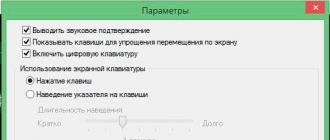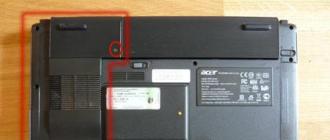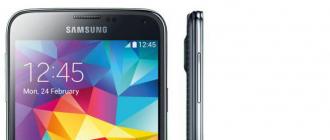The virtual (on-screen) keyboard is an analogue of the physical keyboard, which is controlled by . This article will show you how to enable the on-screen keyboard on Windows 7, 8, as well as how to configure, use and start it, disable it when the OS boots.
The keyboard on the computer screen is necessary in such cases:
- there is no physical input device.
- The input device is not working properly or the keys are not working on it.
- Health problems holding back from normal input
How to turn on the keyboard on the computer screen
The launch file of the virtual input device is located in the System32 folder of the Windows directory and is called osk.exe, from here you can call the virtual keyboard, but few people will use such actions. There are enough ways to enable the on-screen keyboard on Windows 7, 8. Let's look at each of them in more detail.
Enabling virtual input device in Windows 7:
To configure the input format and other settings, click the "Settings" button. Here you can change the following settings:
- Audible Confirmation – Each press of the virtual keys will emit a beep.
- Enable numeric keypad - enables additional buttons on the right. With the help of it was made in the last article.
- Keystrokes - sets the input by clicking the left mouse button.
- Hovering over the keys - the character is entered when the mouse cursor is hovered over it, with the ability to select the hover duration.
- Scanning keys - selection of a range of buttons in one line across the entire width, then after pressing the selection keys, scanning takes place over the selected line in a smaller range until the required button is pressed. You can set the scanning speed.
- Text prediction - options allow you to suggest word options when typing the first letters and put a space after them.

After changing the parameters, do not forget to click OK.
I would also like to note that when you press Fn, the F1-F12 buttons appear in place of the numbers. When the numeric keypad is enabled, press Num Lock to access the numbers.

In Windows 7, 8, there are practically no differences in the on-screen keyboard, except that in the eight there are a number of additional buttons for improved control. These are the Nav (move), Mv Up (up), Mv Dn (down), Dock (pin), Fade (disappear) buttons.

So we looked at all the ways to enable the on-screen keyboard on Windows 7, 8, as well as the startup process, disabling its startup. The virtual input device fully mimics the actions of the buttons on a conventional keyboard and can be customized to suit your needs.
Keyboard
on your computer
The on-screen keyboard on a computer refers to
to Accessibility in Windows 7.
If you have trouble with a regular keyboard
on a computer (laptop) - it broke, turned off, and you
no time to wait, urgently need to print a message - look for
On-Screen Keyboard on your computer.
For a one-time connection of the On-Screen Keyboard, click "Start" → "All Programs" → "Accessories" → "Accessibility" → "On-Screen Keyboard".
The on-screen keyboard is large enough (± 865 x 245 px) and comfortable to use. If you use it constantly, you can get used to it and do without a regular keyboard.
To switch the keyboard from Russian to English - use
RU and EN icons on the computer taskbar (below the screen).

And if you want "On-Screen Keyboard" to come out all the time,
along with Windows boot, then "Start" → "All Programs" → "Accessories" → "Ease of Access" → "Ease of Access Center".

Enable On-Screen Keyboard and click the link below
"Remove all options".
You can use the On-Screen Keyboard in the same way as a normal keyboard.
Only with a mouse. Open Notepad or WordPad, open the On-Screen Keyboard and type. The “on-screen keyboard” always sits on top of Notepad, and if it prevents you from seeing what you are typing, move it to the place you need.

To do this, press the left mouse on the title bar
(top, blue) and drag.
On the "On-Screen Keyboard" there is an option to enable an additional numeric keypad. To do this, press the "Options" key, in the lower right corner of the keyboard and in the dialog that opens, check the button to the left of "Enable numeric keypad" and click "OK". After that it will look like this:

Disable - again press the "Options" key and uncheck.
If you press the "Fn" key, then turn on
function keys F1 - F12

At the same time, if you turn on the On-Screen Keyboard for one-time use, then the function keys do not work, but simply - the entire row closes when you press any of the keys. But if you connect the "On-Screen Keyboard" through the "Ease of Access Center" for permanent work and the "On-Screen Keyboard" is loaded when Windows boots, then the function keys will perform their functions, as in a regular keyboard.
I can't tell if all Operating Systems have an On-Screen Keyboard, but Windows Vista and Windows 7 have it.
Instructions for installing and configuring the on-screen keyboard. Differences between applications that add virtual keys to the screen. Change the color scheme, location and opening method. How to make touch keys bigger or smaller.
Standard on-screen keyboard
Before opening the virtual keyboard on the computer, add the corresponding item to the bottom panel. To do this, call the context menu by right-clicking on any free space on the taskbar. After that, go to the "Panels" menu section and click on the "Touch keyboard" line.
A new item will appear to the left of the icons in the system tray. Click on it to make an on-screen keyboard. If the section is not added to the taskbar, make sure that the "Touch keyboard" item is activated. After that, end the current session of the OS using the "Exit" item in the "Start" menu. Log in again and check for the button.

Important! If logging in again doesn't help, restart your computer.
Touch keys on the computer screen have a standard layout set in the operating system. You can change their language by pressing the lower right button. To make the window stretch to the full width of the screen, click the button in the upper right corner, next to close. In addition to the letters of the selected layout, touch input allows you to add emoticons and special characters. The relevant sections are in the lower left corner.

Free Virtual Keyboard app
If Windows touch input does not work, use a non-standard virtual keyboard. This can be done using the Free Virtual Keyboard utility. The application is free and works without installation on a computer. To call the keyboard, download the file from the developer's site and run it. The window can be resized, and the keys will adjust to the selected width and height.

Advice! Using the slider in the application window, the transparency level of the keys is adjusted.
Video tutorial: Quickly turn on the on-screen keyboard
Hot Virtual Keyboard
Compared to the previous one, this utility provides more options for customizing the display and screen input functions. After installing on your computer and launching Hot Virtual Keyboard for the first time, a wizard will open allowing you to make the initial setup. It includes four steps:
- Greetings
- View selection
- Other settings
- Ending
At the first step, the program offers to change the interface language and connect additional features. To automatically download, activate the first checkbox: "Startup with Windows". In the absence of a physical keyboard, it is recommended to make the second item active. This will help you enter your password to log in using your mouse or touchscreen.

At the second stage, you can choose the look and style of the main window of the program. Check the desired theme in the left table, and then select its style in the right. The list of available styles may change on the screen, depending on the specified theme.

Today, there is probably no such person who would not use the Internet, would not go to social networks or would not have a mailbox where important information is stored for him. However, all logins and passwords, as well as entering bank card numbers that allow you to pay for a particular product in online stores, are not secure through a regular keyboard that is connected to a computer via USB.
In order to protect your data from spyware, through which they fall into the hands of intruders, you need to use the virtual keyboard.
What is a virtual keyboard?
The virtual keyboard is a standard component of the Windows family of operating systems. Its use is possible not only when entering confidential information, it will also become a convenient tool for people with disabilities and in cases where, for some reason, a regular keyboard has failed, and something urgently needs to be done on the computer.
Photo: on-screen keyboard on a computer
The main purpose of the virtual keyboard is to protect confidential information from intruders. Under reliable protection are users who work on the computer on the following web browsers:
- Mozilla Firefox 15.x - 17.x;
- Internet Explorer 8 - 10;
- GoogleChrome 9.x - 12.x.
In the case when personal data is entered through a virtual keyboard when a site is hacked, the information will not be protected, since it directly goes to scammers.
Ways to turn on
The virtual keyboard can be opened in several ways:

Almost everyone knows how to enable the virtual keyboard from the keyboard. To do this, simultaneously press the following keys: CTRL + Alt + Shift + P.
Enabling the virtual keyboard through the web browser window is as follows: you need to open the browser window and click on the button in the toolbar with the mouse. You can enable the virtual keyboard directly through the context menu of the program icon by right-clicking on the program icon and selecting "Virtual Keyboard" in the context menu.

Photo: context menu of the program icon
The virtual keyboard in Windows 7 can be launched as follows:

Overview of virtual programs - keyboards
The virtual keyboard is a standard component of the Windows family of operating systems. However, if for some reason it does not suit you, such a keyboard can be easily downloaded on the Internet. Of all the currently existing virtual keyboards, the most popular are:
- ComfortOn-ScreenKeyboard 5040 (interface Russification is present, volume - 3.63 MB, OS - Windows 2000 and higher);
- FlorenceVirtualKeyboard 0.5.0 (no Russification of the interface, volume - 1.89 MB, OS - Linux);
- GreatisVirtualKeyboard 1.1 (interface Russification available, volume - 560 KB, OS - Windows 98/ME/XP);
- JitbitVirtualKeyboard 2.22 (interface Russification, volume - 539 KB, OS - Windows 2000 and higher);
- KeymanDesktop 8.0.3 (no Russification of the interface, volume - 7.65 MB, OS - Windows 2000 and higher);
- Klava 4.0 (no Russification of the interface, volume - 22 Kbytes, OS - Windows 2000 and higher);
- Mountfocus 3.2 (there is no Russification of the interface, the volume is 5.67 MB, OS is Windows 2000 and higher);
- VirtualKeyboard 32.1.56 (no Russification of the interface, size - 440 KB, OS - Windows 2000 and higher).
How to turn on the computer using the keyboard
It happens that the system unit from the computer is located in a hard-to-reach place, for example, hiding it from small children or simply freeing up space in this way. And then many people ask the question “how to turn it on through the computer keyboard?”.
In order to start the computer without pressing the "Power" button located on the front case of the system unit, you need to make special settings in the BIOS that will allow you to turn on the PC through the keyboard.
To do this, when you turn on the computer, continuously press the Del key. If suddenly this method did not help you enter the BIOS, then you can try pressing the Esc, F2 or F10 button. As a result, a BIOS interface will appear on your monitor screen, through the menu of which you need to navigate using the “arrows” up / down, right / left, and the “Enter” key is used to edit or select parameters.

So, in order to make settings in the BIOS, you need:

After the done manipulations, the computer should reboot. That's all, now your computer will turn on using the key combination that you selected in the BIOS settings. In order to turn off the PC using the keyboard, you must:

There is another option to turn off the PC through the keyboard: the key combination Alt + F4. Next, a window will appear in which you need to select the “shutdown” item and press the “Enter” key.
Well, if your keyboard is broken and the PC gives an error when you turn it on, then you will probably have the question “how to turn on the computer without a keyboard”. If you have the opportunity to borrow a keyboard from someone, then you need to go into the BIOS, find the “Set UP-ehalt” section and set “no errors” instead of “on errors”. Thus, turning on the PC will occur without a keyboard.

The keyboard allows you to not only turn on / off the computer, but also turn on / off the sound and adjust its volume.
How to turn on the sound on the computer using the keyboard? Everything is very simple. To do this, press the F10 key and use the F11 and F12 keys to adjust the volume.
On-screen keyboard in operating systems
The on-screen keyboard in Windows 7 and Windows 8 operating systems looks different and some features may be available only in certain operating systems. Therefore, when downloading and installing the on-screen keyboard, you need to pay attention to the "supported OS" sub-item.

This is necessary not only in order for the on-screen keyboard to be successfully installed on the PC, but also in order to “fully” use its functions.
What to do - the keyboard does not work
If the keyboard does not work, it is necessary to determine the cause of its failure. The reasons why the keyboard may break are divided into two types:
- software;
- hardware.
If the cause of the breakdown is the hardware of the keyboard, it will be very problematic to correct the current situation without certain knowledge and skills on your own. It's easier to replace your old keyboard with a new one. But first, check the cable through which the keyboard is connected to the PC. It may have come loose or damaged. If the cable is intact and does not come off, try restarting the computer. Maybe there was a glitch while it was running. If restarting the PC was unsuccessful and the keyboard still does not work, try launching the Start panel with the mouse and go to the Control Panel, and then to the Hardware and Sound. If there are problems with the keyboard, it will be marked in yellow with an exclamation point in the system.
Using the mouse, select the keyboard and click "Delete", and then close all tabs.
Video: what to do if the keyboard on the computer does not work
Next, open the "Hardware and Sound" window back, select "Add a device". After the OS has searched, the keyboard will be found and installed. If after these manipulations the keyboard does not work, then you will need to replace it with a new one or use the virtual keyboard. The keyboard and mouse are little valued these days, but these components are an essential part of a complete PC experience. Virtual or on-screen keyboards are also important elements of computer operation, because only they can protect your social networks from hacking and protect your personal data of bank details or passports from intruders.
The on-screen keyboard may be the best way to enter information if using a physical keyboard is difficult for one reason or another. She looks just like the custom. Letters can be selected with the mouse, switch or joystick.
There are several situations where the on-screen keyboard can come in handy, of which the three most common reasons are:
- Some of the keys on your physical keyboard don't work, this often happens when water gets in, especially on a laptop where it can be difficult to change it.
- The physical keyboard has completely stopped working. This happens due to problems with drivers and viruses.
- You need . Even if it works, entering text in a foreign language from a physical keyboard, which is signed only in Cyrillic and Latin, is extremely difficult. In this case, this utility will greatly simplify the work with the computer.
This does not mean that you will have to use it all the time, but it is quite possible to wait a while before repairing it.
Enable the on-screen keyboard
Step 1. Open the Start menu by pressing the button of the same name, the Windows key, or Ctrl + Esc. Open the control panel.

Step 2 Go to the "Accessibility" section. This section contains links to help you make changes to your computer settings for better use. The changes you make to your computer settings will be saved so that you can use your computer the next time you log in.
You can also use these tools to undo any changes you have made and return your computer to its original settings.

Step 3. Go to the "Ease of Access Center" section.

Go to the section "Ease of Access Center"
Step 4 In the Ease of Access Center menu, click on the Enable On-Screen Keyboard button.

Click on the "Enable On-Screen Keyboard" button
As soon as you click on this button, a keyboard will appear on the screen. It will be immediately usable, but you can also make some changes.

Step 5. If you look closely at it, you will notice two special buttons in the lower right corner. These are the Options and Help buttons. Click on the first one to make personal changes.

There are two input methods:
- input by pressing a button with the mouse;
- input by hovering the cursor and holding it in one position.
For the second case, you need to configure an individual . This is convenient when working on a laptop without a mouse.
You can also configure this using a keyboard shortcut:
- "Alt" + "C" to enter each individual character with a mouse click.
- "Alt"+"H" to access the keyboard with a mouse or other pointing device by hovering over a character to type it.
- "Alt" + "S" to access the keyboard using the spacebar, switch, or gamepad.
Step 6 Once the keyboard is set up, you can pin it to the taskbar for faster and easier access.

Third-party programs to control the keyboard from a computer
The standard Windows utility is a handy application that allows you to manage control, but this is not the only development. There are a lot of them, and each of them has its own advantages and disadvantages.
| Name | Short description | Advantages |
|---|---|---|
| On-Screen Keyboard Portable | The program is a virtual keyboard that you can install on a USB drive and run on any PC. The keyboard itself is not particularly attractive, but functional. You can resize it to choose what's good, and it remembers your settings when you exit. This type of keyboard protects you from hardware keyloggers, but not against keylogger software, so it doesn't protect you from malware that tries to save entered passwords and so on. | Lightweight and portable |
| Exbi Keyboard | This on-screen keyboard makes it easy to type in multiple languages without having to install a full language pack. It can handle multiple languages at the same time. It comes with English and Urdu by default, but you can add other languages as well, and switch easily by pressing CTRL+Space. Free and supports many Unicode languages | The user can change the background color and the keys themselves |
| Jitbit Virtual Keyboard | You can type with a mouse, a stylus (a digital pen used by Tablet PC touch screen devices). The virtual keyboard also protects your trusted data by preventing snooping. Enter secure passwords, personal details, secret information with Jitbit's virtual keyboard | Completely free, protects your privacy |
Note! Be careful with the apps you use. Trust only trusted developers, and, of course, if possible, from Windows, in order to protect yourself from the intrigues of intruders.
So, the breakdown of the physical keyboard is not a problem, this problem is solved in two clicks. Use one of the suggested methods, and then you can easily wait for the day when your physical keyboard is fixed.
Video - How to enable the on-screen keyboard on Windows 7






